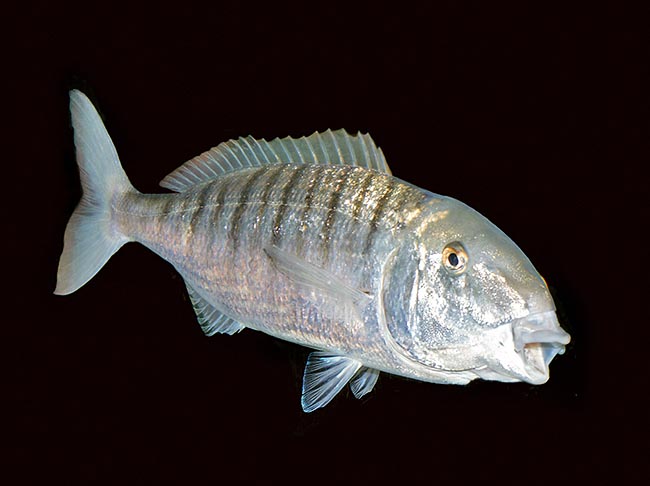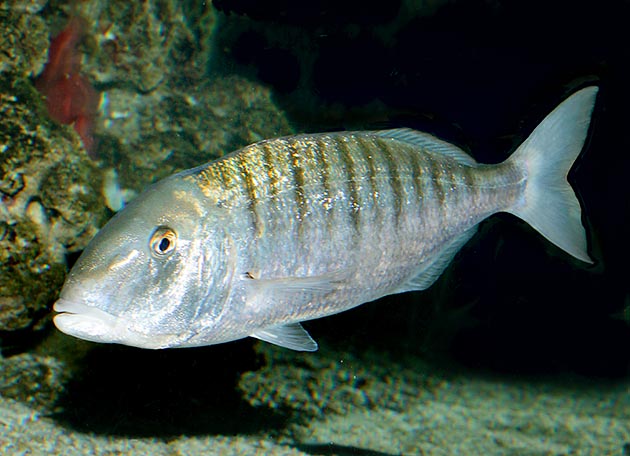Family : Sparidae

Text © DrSc Giuliano Russini – Biologist Zoologist

English translation by Mario Beltramini

Lithognathus mormyrus is common along Mediterranean coasts where it reaches the 30 cm © Giuseppe Mazza
Among these species, one which is much important is the Sand steenbras (Lithognathus mormyrus Linnaeus, 1758).
The taxonomy tells us that it is afferent to the group of Fishes (Pisces), class of Osteichthyes (Osteichthyes), subclass of Actinopterygians (Actinopterygii), order of Perciforms (Perciformes), suborder of the Percoids (Percoidei), family of the Sparids (Sparidae) and genus (Lithognathus).
Zoogeography
The fishes of the genus Lithognathus, populate all the warm and temperate seas of the world; in the specific, we find the sand steenbras in the Black Sea, the Red Sea, Indian Ocean (especially in the waters of Mozambique), Eastern Atlantic, from Gibraltar Strait to the Cape of Good Hope and in the coastal waters of the Canary and Cape Verde Islands. It is also quite abundant in the Mediterranean Sea.
Ecology-Habitat
The sand steenbras is a fish (as well as the other species of the genus), tending to live in not too deep waters, from 10 to 120-130 m of depth (other species of sparids prefer to live along the coastlines. It loves the soft bottoms, and, as in the Mediterranean, covered by prairies of Posidonia oceanica, family Posidoniacee, a monocotyledonous, angiospermous, aquatic plant. It nourishes of fishes, crustaceans, molluscs, annelids and of some other sea organisms.
Morpho-physiology
The sparids are endowed of very robust teeth and variously specialized: in some species, the teeth are cutting and incisor-shaped, otherwise, they are similar to the molars, used for crushing the most coriaceous material, for instance the exoskeleton of the crustaceans and of the molluscs, or sharp and with these ones they can tear off easily the flesh of their preys, for instance, fishes.

Unmistakable due its vertical bands livery, like the Bream, changes sex while ageing © Giuseppe Mazza
In the case of the sand steenbras, sharp teeth and molar-like ones are present.
However, the teeth are not planted into the palate, but n the jaws.
The dorsal fin of the sand steenbras, similarly to the other species of sparids, is quite expanded, supported, in the front, by thorny rays, as well as the anal one, whilst the ventral fins are moved much forward.
The Lithognathus mormyrus reaches the length of 30 cm and has a livery with a fundamental silver-grey colouration, broken by a dozen of blackish or grey vertical lines. There is no somatic sexual dimorphism between the sexes.
Ethology-Reproductive Biology
This species of sparid lives in small isolated schools, formed by about twenty individuals; in reality, compared to the other sparids, this fish cannot be defined as coastal, as, even if it stays preferably close to the coasts during the warmest months, when the winter approaches, it goes to the open seas and to depths (100-130 m) where it cannot be excessively affected by the temperature changes.
The female lays very small, diaphanous-transparent, eggs, but never grouped in clusters due to the absence of oily extensions.
As is the case of the Gilt-head bream (Sparus aurata), its cousin, or of the Common seabream (Pagrus pagrus), also here we have the phenomenon of the “proterandrous hermaphroditism”, which means that the fries are born as males and then become females with the time. This fish has an average lifespan of 13 years.
Also this species is actively fished for the goodness of its flesh; in spite of this, thanks to specific fishing programmes which do not hinder its reproduction, as they respect its vital cycle, this fish, after the IUCN, is not an endangered species, at least for the time being.
The vulnerability index of this species is of 40 over 100.
Synonyms
Pagellus goreensis Valenciennes, 1830; Pagellus mormyrus Linnaeus, 1758; Sparus mormyrus Linnaeus, 1758.
→ For general information about FISH please click here.
→ For general information about BONY FISH please click here
→ For general information about CARTILAGINOUS FISH please click here.
→ To appreciate the BIODIVERSITY of BONY FISH please click here.
→ To appreciate the BIODIVERSITY of CARTILAGINOUS FISH please click here.
